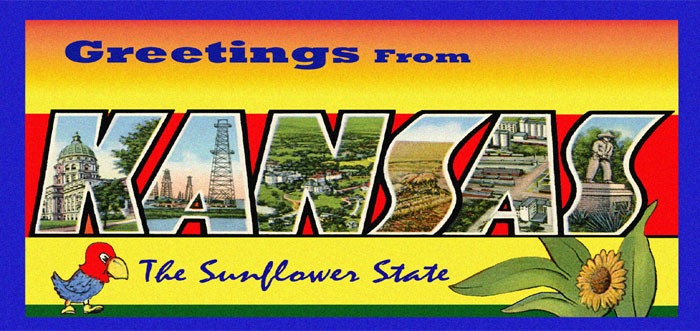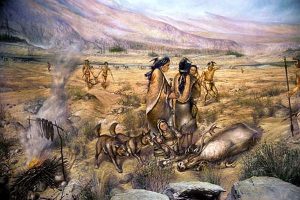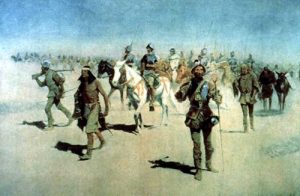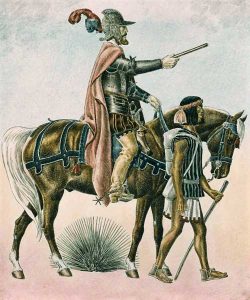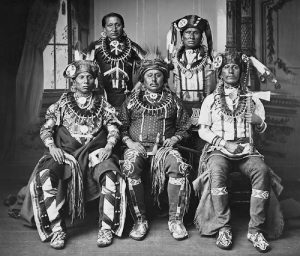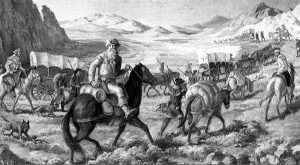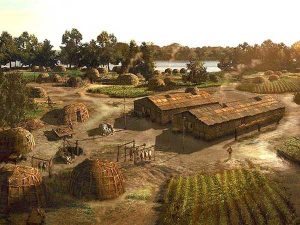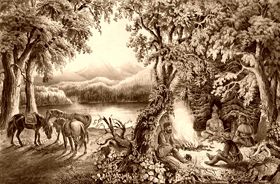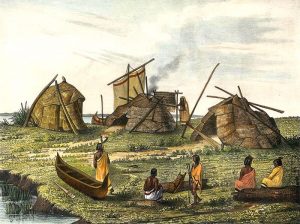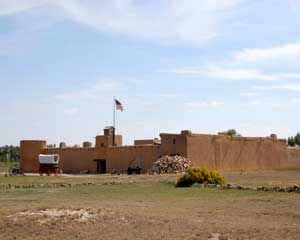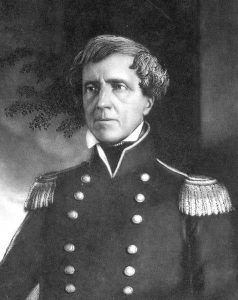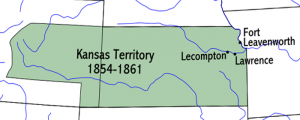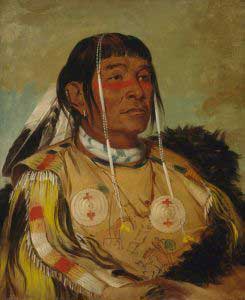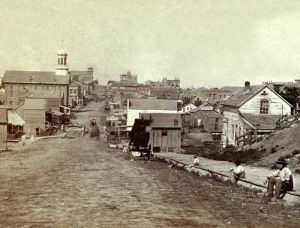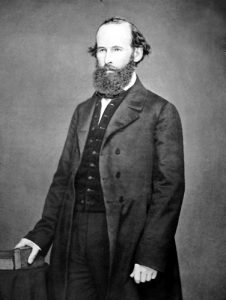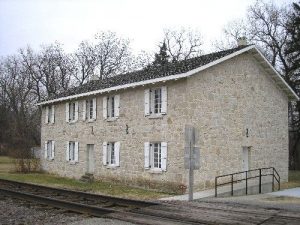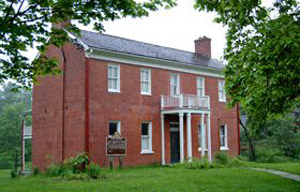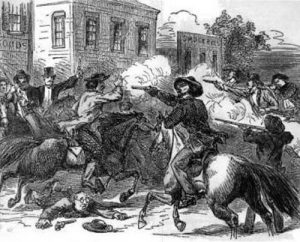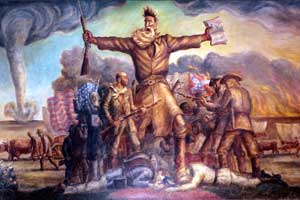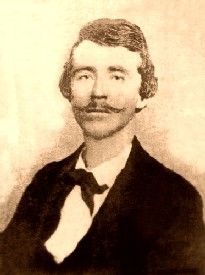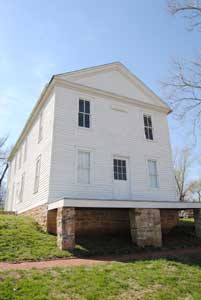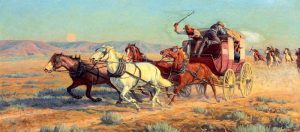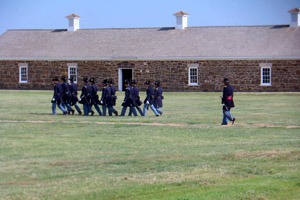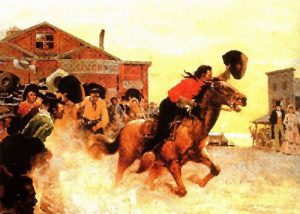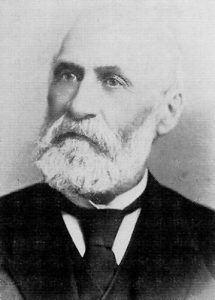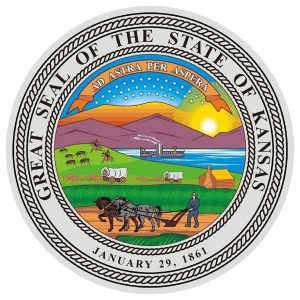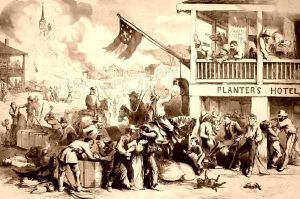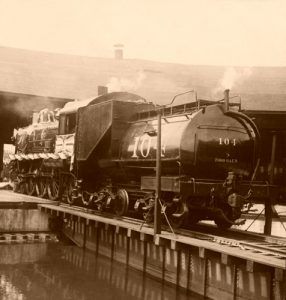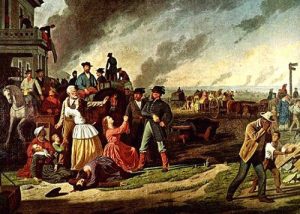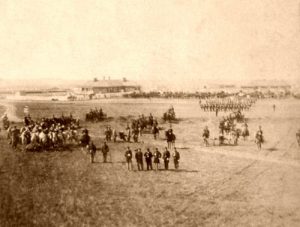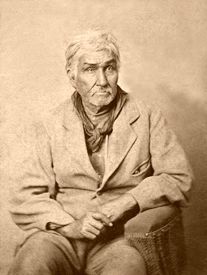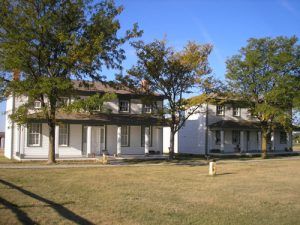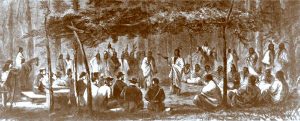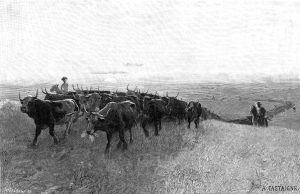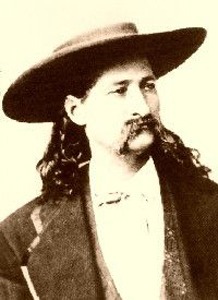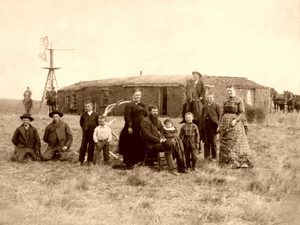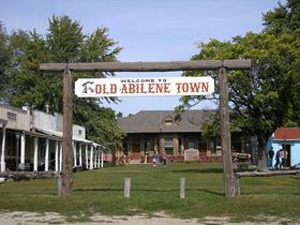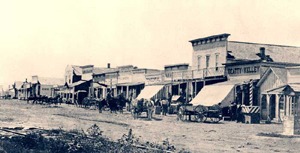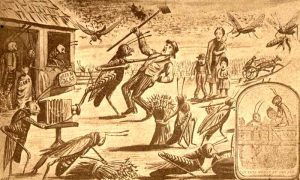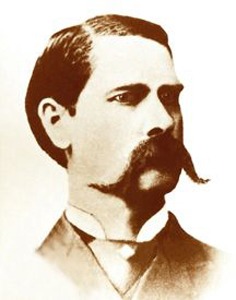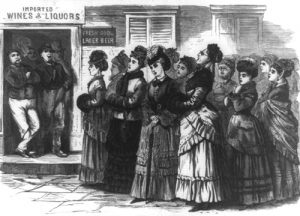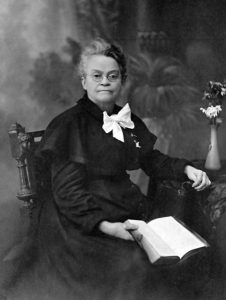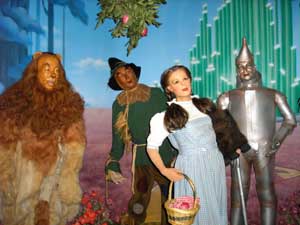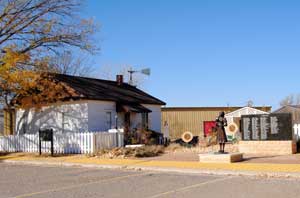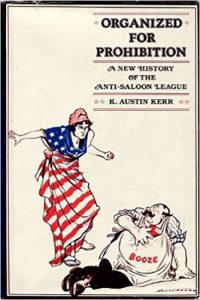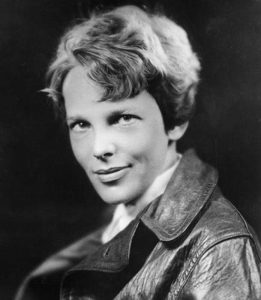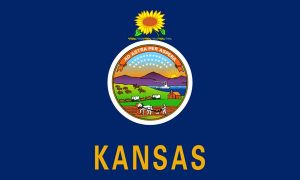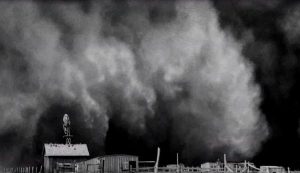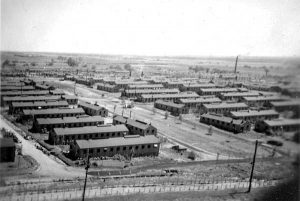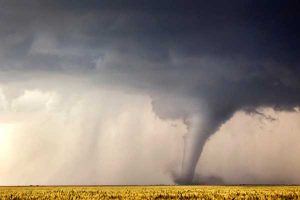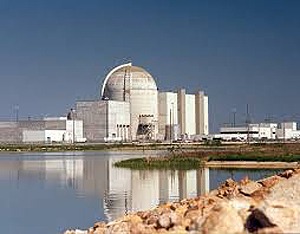12,000-7,000 BC – Paleoindian Period — The first people to live in Kansas were descended from Asian immigrants who entered North America by crossing into Alaska.
1 – 1000 – Woodland Period — This time was marked by great changes in social systems and living practices, including the widespread making of pottery vessels and improvements in chipped stone tools and bows and arrows.
1000 – 1500 – Village Gardener Period – During this period, most Native Americans began a dual economy based on bison hunting and farming, supplemented by small-scale hunting and gathering of wild foods. The use of the bow and arrow became widespread.
1500 – 1800 – Protohistoric Period – The time shortly before and after the arrival of Europeans in the New World.
1540s – The Wichita and Pawnee Indians lived in the region that would become Kansas.
1540-1541 – Spanish explorer Francisco Vazquez de Coronado marched north from Mexico in search of the Seven Cities of Cíbola. He was told about the Land of Quivira in New Mexico, and he turned northeast. By the summer of 1541, he had reached the Arkansas River in Kansas, crossing it near present Dodge City and continuing northeast to a site now called Coronado Heights, a hill northwest of Lindsborg, Kansas. Having found no gold in Quivira, Coronado and his men returned to New Mexico.
1542 – Father Juan de Padilla, a priest who had accompanied Coronado, returned to Kansas, hoping to bring Christianity to the Indians. However, he was killed by those he tried to help. Father Padilla is said to have been the first Christian martyr in America.
1600s – Kanza and Osage Indians arrive in Kansas.
French explorers & fur traders come down from Canada via the Mississippi River.
1601 – Juan de Onate’s expedition to Quivira.
1673 – Father Jacques Marquette and Louis Joliet explore the Mississippi River from the Wisconsin River to the Arkansas River.
1682 – Rene Robert Cavalier, Sieur de La Salle, reached the mouth of the Mississippi River and claimed all the territory drained by the river and tributaries in the name of France, calling it “Louisiana.”
1650 – Taos Indians irrigate lands along Beaver Creek in Scott County.
1719 – Charles Claude du Tisne explores upper “Louisiana” territory; he visits Osage Indian villages near the mouth of the Osage River and crosses the northeast corner of Kansas to Pawnee on the Republican River
1720 – The French and Spanish fought a battle over the possession of Kansas 50 years before the Revolutionary War. The French and their Pawnee allies massacred Colonel Don Pedro de Villazur and his little Spanish army. The French gained the right to carry on their fur trade in Kansas.
1722 – The French erected Fort Orleans on the Missouri River under the command of Etienne Veniard de Bourgmont.
1724 – French explorer and trader Captain Etienne Veniard de Bourgmont led an expedition into what are now Atchison and Doniphan Counties to establish trade relations with the Indians of the Platte River region. He built Fort Orleans near the mouth of the Kansas River.
The Otoe tribe of the Sioux also inhabit various areas around the northeast corner of Kansas.
1725 – Fort Orleans was destroyed by Kanza Indians.
1739 – Pierre and Paul Mallet lead a party of French traders through Kansas.
1744 – The French built Fort Cavagnial near the present site of Fort Leavenworth. It closed in 1764.
November 1762 – France ceded the province of “Louisiana” to Spain by the treaty of Fountain bleu; “Louisiana” was ceded back to France by the secret treaty of St. Ildefonso.
1764 – Pierre Laclede Luguest and Auguste and Pierre Chouteau, French fur traders, establish headquarters at St. Louis. The development of Kansas fur trade begins.
1790s – The Chouteau family begins fur trading with Kanza Indians.
April 30, 1800 – Louisiana Purchase – The United States concluded a “deal” when it signed an agreement to purchase the entire Louisiana Territory from France. This transaction ended the trading era for Kansas and brought forth the exploration of a new American settlement.
1804 – The Lewis and Clark Expedition begins.
June-July, 1804 – Lewis and Clark camped at several points in the Leavenworth area on the Kansas side of the Missouri River.
July 4, 1804 – At present-day Atchison, Lewis and Clark celebrated the first Independence Day in Kansas by firing a swivel gun. Later, they named it Independence Creek and closed the day with another cannon blast.
July 15, 1806 – Lieutenant Zebulon Pike of the U.S. Army leaves St. Louis, Missouri. He will soon cross Kansas on an exploration expedition during which he will meet with the Indians and sign treaties with them as the representative of the new “White Father.” He continued westward on this journey to discover the mountain that is now called Pike’s Peak. He labels Kansas “the Great American Desert” on his maps.
September 26, 1806 – The first American flag is raised in Kansas by a Pawnee Indian Chief.
1811 – George C. Sibley, a government trader, works among Osage Indians.
1812 – The Missouri Fur Company dissolved and was succeeded by the American Fur Company, which concentrated in Kansas.
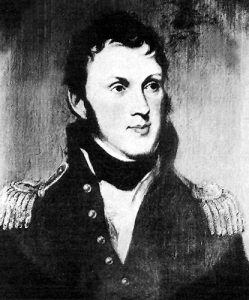
Major Stephen H. Long.
1819 – Stephen H. Long, one of the topographical engineers, led a party to explore portions of Kansas. The Western Engineer was the first steamer to enter the Kansas River.
1820s – The Kansas area is set aside as Indian territory by the U.S. government and closed to settlement by whites.
A band of as many as 1,500 Pawnee live in 40-50 earth lodges in the spring and fall in the large fortified village of Kitkehahki. During the winter and summer, they travel through western Kansas, living in tipis and replenishing their meat supply through successful buffalo hunts.
1820 – Two Presbyterian missions are established for the Osage Indians: the Union on the Neosho River and the Harmony on the Marais des Cygnes River.
September 1, 1821 – William Becknell, a Missouri trader, was the first to follow the route that later became known as the Santa Fe Trail. This event was the official opening of the Santa Fe Trail. Overland trails helped the nation expand to new territories and initiate trade with neighboring countries.
After a brief period as part of Missouri Territory, Kansas returned to unorganized status.
1822 – William Becknell used wagons instead of pack mules or horses to haul trade goods over the Santa Fe Trail. Because Becknell found a good mode of transportation and a passable wagon route, he is credited as the Father of the Santa Fe Trail.
1823 – The boundary between Missouri and Kansas is definitely fixed.
June 1825 – Treaties were negotiated between the federal government and the Kanza and Osage tribes for a cession of Kanza-Osage land onto which eastern Indians could be moved. A right-of-way for the Santa Fe Trail was also granted to Osage Indians at Council Grove.
November 7, 1825 – Missouri Shawnee Indians were the first Native Americans removed from the territory by treaty.
1827 – The government sends Daniel Morgan Boone to teach agriculture to Indians; Boone located on land in what is now Jefferson County.
May 8, 1827 – Fort Leavenworth, first known as Cantonment Leavenworth, was established by Colonel Henry Leavenworth on the Kansas side of the Missouri River as an army post to protect the western frontier and travelers on the Santa Fe Trail.
August 22, 1827 – The first white child born in Kansas was Napoleon Boone, son of Daniel Morgan Boone, at an Indian agency.
1829 – William L. Sublette’s pack train, heading westward by way of Independence, Missouri, for the first time, traveled out the Santa Fe Trail some distance before turning northwest toward the Kansas River. This would become the established Oregon-California Trail route.
The Delaware Indians are moved to Kansas.
1830 – William L. Sublette took the first wagons along the Oregon Trail to the Rocky Mountains.
May 1830 – The Indian Removal Bill of 1830 uprooted the Kickapoo, Shawnee, Delaware, Potawatomi, Wyandot, Ottawa, Chippewa, Iowa, Miami, and Sac and Fox tribes from their homes in the southeast United States, forcing them to move west of the Mississippi River
September 1830 – The Shawnee Methodist Mission was opened, which includes a school, by the Reverend Thomas Johnson and his wife in the Turner area of present-day Kansas City, Kansas.
1830s – The Pawnee are pushed farther north by other Plains Indians. The Kitkehahki village is abandoned as 11,000 more Native Americans from several other states are moved to Kansas.
1831 – Moses Grinter established the first ferry in Kansas. It crosses the Kansas River.
July 1831 – Isaac McCoy was instrumental in founding the Shawnee Baptist Mission, opened by Johnston Lykins a few miles southwest of the mouth of the Kansas River in Johnson County.
August 30, 1831 – The Ottawa Indians ceded land to the United States and moved to a small reservation on the Kansas River and its branches.
1832 – Kickapoo, Potawatomi, Kaskaskia, Peoria, Wea, and Piankeshaw Indian reservations are established in Kansas.
October 24, 1832 – The U.S. government moved the Kickapoo to a reservation in Kansas.
October 29, 1832 – The Piankeshaw and Wea Indians agreed to occupy land in Kansas.
1833 – Jotham Meeker came to the Shawnee Baptist Mission, bringing with him the first printing press to be set up on Kansas soil.
September 21, 1833 – A Treaty was made with the United States and the Otoe tribe, ceding their country south of the Little Nemaha River.
1834 – Bent’s Fort, a fur trading post, is established on the upper Arkansas River in present-day Colorado, thus opening the Bent’s Fort branch of the Santa Fe Trail.
1835 – The Kanza, or Kaw tribe, are counted in the Kansas Census and numbered 1,606.
1836 – The Sac, Fox, and Iowa Indians are moved to Kansas.
1837 – Reverend Jotham Meeker founds Ottawa Baptist Mission (now Ottawa University).
Surveying begins for the Fort Leavenworth-Fort Gibson Military Road. It will link the forts on the “Permanent Indian Frontier.”
February 11, 1837 – The United States agrees to convey to the Potawatomi an area on the Osage River, southwest of the Missouri River.
1839 – The Shawnee Methodist Mission was relocated on a 2,000+ acre grant in present-day Fairway, Kansas.
1840 – Miami Indians are moved to Kansas.
Joseph and Ahcan Pappan (pah-pan) established a ferry across the Kansas River, where Topeka now stands.
1841 – The Bidwell-Bartleson party is the first emigrant wagon train bound for the Pacific. They leave Independence, Missouri, via “Sublette’s Trace,” which develops into the Oregon-California Trail.
1842 – The treaty between the United States and the Wyandot moved the tribe to the junction of the Kansas and Missouri Rivers on land that was shared with the Delaware until 1843.
May 30, 1842 – Fort Scott was established at the Marmaton Crossing of the Fort Leavenworth-Fort Gibson military road in present-day southeast Kansas.
June 1842 – Lieutenant John C. Fremont, with Kit Carson as his guide, explores the Kansas and Platte Rivers.
1843 – Wyandot Indians settled on a reservation in eastern Kansas and established the city of Wyandot (Kansas City, Kansas.)
The first group of Oregon emigrants, a population of 900, sets out from Elm Grove. Larger groups passed through Kansas in 1844 and 1845.
1844 – The Wyandot Indians established the first free school.
The first move to organize Kansas into a territory was made at Uniontown by Missourians.
1846 – Crossing points above St. Joseph, Missouri, such as Iowa Point and Elizabethtown, are first used by Pacific-bound emigrants.
The Mexican-American War began, and General Stephen W. Kearney marched from Fort Leavenworth to California. During the war with Mexico, Fort Leavenworth is the chief outfitting post for the army of the West.
Spring, 1846 – The Kanza (Kaw) Indians signed a treaty with the government, ceding their reservation land along the Kansas River near Topeka of two million acres in exchange for a new but smaller reservation located along the upper valley of the Neosho River in what is now Morris County.
1847 – The Potawatomi were moved again to an area of 576,000 acres, the eastern part of the lands ceded to the United States by the Kansa tribe in 1846.
Fort Mann is constructed to provide protection along the Santa Fe Trail. It will soon be abandoned.
April 1847 – A reservation 20 miles square was established in present-day Morris County near Council Grove. The Kanza Indians were relocated from their reservation near Topeka to the new reservation, where they would remain until 1873.
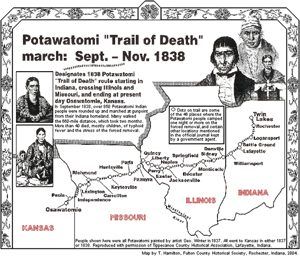
Map courtesy Fulton County Historical Society, Rochester, Indiana.
November 4, 1838 – The Potawatomi Trail of Death ends in Kansas. Under the Indian Removal Act, 859 Potawatomi people were forced to walk more than 600 miles to Kansas. As many as 90 tribes were removed to Kansas in the mid-19th century, and hundreds of native people lost their lives during their first few years here.
1849-1850 – The Kaw Mission at Council Grove was built by the Methodist Episcopal Church to serve as a school. The school was closed in 1854 and later became the first school for the settlers’ children.
1850 – Euro-Americans squatting on Native American land in Kansas begin pushing for the region to be opened for settlement.
Coal is found near the present site of Pittsburg and dug by settlers for their own use.
August 8, 1850 – Fort Atkinson (also called Fort Sod) was established about two miles west of present-day Dodge City on the left side of the Arkansas River.
1851 – Momentum builds to take the Kansas land from the Native Americans that they had been promised “permanently.”
September 17, 1851 – Cheyenne and Arapaho tribes negotiated with the United States for land in western Kansas (the current state of Colorado).
1852 – Flour milling got its start in Kansas by Mattitins Splitlog in Kansas City.
Congress begins the process of creating the Kansas Territory.
May 17, 1853 – Camp Center is built by Major Ogden on the Kansas River near the Republican River to protect both the Santa Fe and Oregon Trails. It was quickly re-named Fort Riley and became the new supply depot for the Army in present-day Riley County.
July 1853 – The Wyandot Indians attempted to establish a Territorial government in their section of Indian Territory and elect delegates. However, Congress fails to recognize the act or the delegates.
Summer, 1853 – George W. Manypenny, U.S. commissioner of Indian affairs, is directed by Congress to negotiate treaties with the Kanza and Neosho Indians to recede to the U.S. Government all but a fraction of the land that, a quarter-century before, had been assigned them “forever.” Manypenny was reluctant to do so.
1854 – Fort Atkinson was abandoned due to the poor condition of the sod buildings.
Swiss immigrants first arrived and settled in present-day Potawatomie, Nemaha, and Allen Counties.
The Swan Creek and Black River bands of the Chippewa tribe inhabit 8,320 acres in Franklin County.
Nearly all the tribes in the eastern part of the Territory ceded the greater part of their lands prior to the passage of the Kansas territorial act and were eventually moved south to the future state of Oklahoma.
The First regular newspaper in Kansas: Kansas Weekly Herald is published in Leavenworth.
Kansas is home to five Indian Nations as well as 20 tribes the U.S. Government relocated to the area.
Jan-May, 1854 – 1854 Congress debates Kansas-Nebraska Bill. President Pierce signed the bill creating two Territories on May 31.
March 1854 – Manhattan is founded by Isaac T. Goodnow.
Clarina Nichols arrives to urge the Kansas state constitution, when written, to give women equal rights.
March 15, 1854 – Otoe and Missouri Indians cede to the United States all their lands west of the Mississippi, except a small strip on the Big Blue River.
March 30, 1854 – Lands owned by the Kaskaskia, Peoria, Piankeshaw, and Wea Tribes are ceded to the United States.
May 1854 – The towns of Leavenworth, Atchison, and Lawrence are laid out and organized.
May 6, 1854 – The Delaware tribe cede all their lands to the United States, except a reservation defined in the treaty.
May 6 & 10, 1854 – The Shawnee tribe cedes 6,100,000 acres, reserving only 200,000 acres for homes.
May 17, 1854 – The Ioway tribe cedes their lands, retaining only a small reservation.
May 18, 1854 – Lands ceded by the Sac and Fox.
The Kickapoo tribe cede their lands, except 150,000 acres in the western part of the Territory.
May 30, 1854 – The Kansas-Nebraska Act was passed and signed by President Franklin Pierce, and Kansas Territory was organized and opened up for settlement. Its boundary included eastern Colorado, west to the Continental Divide. The purpose of the Kansas-Nebraska Act was to open the country to transcontinental railways. The Kansas-Nebraska Act is responsible for causing the label “Bleeding Kansas.” The incorporation of popular sovereignty made the territory’s residents responsible for the question of slavery in their own backyard. The proximity of Kansas to slave-owning Missouri and the lack of any natural border between the two regions prompted an influx of pro-slavery individuals into the new territory when it opened up for settlement.
Summer, 1854 – Eli Thayer of Worcester, Massachusetts, founds the Massachusetts Emigrant Aid Society to promote the settlement of anti-slavery groups in Kansas with the ultimate objective of making it a Free-State. This company helped to found Lawrence, Kansas, which was named for Amos A. Lawrence, a promoter of the Emigrant Aid Society.
June 10, 1854 – Missourians hold a meeting at Salt Creek Valley, a trading post three miles west of Fort Leavenworth, where a “Squatter’s Claim Association” is organized.
June 30, 1854 – Andrew H. Reeder was appointed the first territorial governor of Kansas by President Franklin Pierce.
July 28, 1854 – The first members of the New England Emigrant Aid Society arrive in Kansas to help her become a “Free-State.”
August 1854 – The Masons organize the first lodge in Kansas, the Grove Lodge, at Wyandotte (now Kansas City, Kansas.)
August 1, 1854 – Twenty-nine northern emigrants, mostly from Massachusetts and Vermont, are the first to arrive in Lawrence, Kansas. A second party of 200 men, women, and children arrive in September.
October 1854 – The First Congregational Church in Kansas is founded in Lawrence.
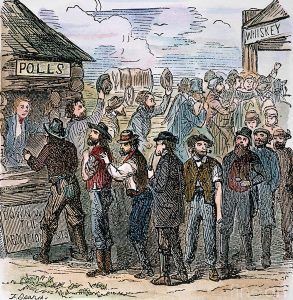
Voting in Kansas.
November 29, 1854 – First election held in Kansas. Pro-slavery Missourians flooded the state to vote, where armed pro-slavery advocates intimidated voters and stuffed ballot boxes. Andrew H. Reeder was elected as the first territorial governor of Kansas.
December 1854 – Topeka was founded by five anti-slavery activists, including Cyrus K. Holiday.
1855 – The Valley Falls Mill was built by Isaac Cody, father of Buffalo Bill Cody.
Violence begins to break out between pro-slavery and abolitionist factions.
Kansas population is estimated at 8,601.
February 1855 – Five sons of John Brown settle near Osawatomie.
March 30, 1855 – Territorial Legislature election held, where again pro-slavery Missourians flooded the state. After winning the territorial legislature, the pro-slavery officials ousted all Free-State members, secured the removal of Governor Andrew Reeder, and adopted pro-slavery statutes. and began to hold their sessions in Lecompton, Kansas, about 12 miles from Lawrence.
June 1855 – A Free-State Convention is held at Lawrence, which declares: “In reply to threats of war… our answer is: ‘We are ready.'”
July 1855 – The first territorial Capitol of Kansas was built of native stone at Pawnee on the Fort Riley reservation.
The ” Bogus Legislature” meets at Pawnee, and pro-slavery members gain control and adjourn to Shawnee Mission.
The expelled Free-State legislators meet at Lawrence.
Governor Andrew Reeder declares the Shawnee Mission Legislature illegal.
Shawnee Mission Legislature asks President Pierce to remove Governor Reeder.
President Pierce removes Governor Reeder.
July 16, 1855 – The pro-slavery capital was moved to the Shawnee Methodist Mission in present-day Fairway, Kansas.
October 1855 – In retaliation for the illegal first territorial legislature, the abolitionists set up a rival government at Topeka.
October 7, 1855 – Abolitionist John Brown arrives in the Osawatomie, Kansas, area to join his five sons, who had become engaged in the fight for the Free-State cause. He stays in the log cabin home of the Reverend Samuel and Florella Adair, his half-sister.
November 11, 1855 – A Free-State constitution was framed in Topeka; however, it did not receive serious consideration in Congress.
December 1, 1855 – A small army of Missourians, acting under the command of “Sheriff” Jones, laid siege to Lawrence in the opening stages of what would later become known as “The Wakarusa War.” The intervention of the new governor, Wilson Shannon, kept the pro-slavery men from attacking Lawrence.
1856 – The pro-slavery territorial capitol was “officially” moved to Lecompton, a town only 12 miles from Lawrence.
Cholera raged at Fort Riley.
April 1856 – A three-man federal congressional investigating committee arrived in Lecompton to investigate Kansas’s troubles. The majority report of the committee found the elections to be fraudulent, stating that the Free-State government represented the majority’s will. However, the federal government refused to follow its recommendations and continued to recognize the proslavery legislature as the legitimate government of Kansas.
May 21, 1856 – The Sacking of Lawrence – A motley group of some 700 armed pro-slavery enthusiasts raided Lawrence, the stronghold of the abolitionist movement. They destroyed the Free State Hotel (now the Eldridge Hotel), smashed the presses of two Lawrence newspapers, and killed one man.
May 22, 1856 – After making a fiery speech called “The Crime Against Kansas ” in the United States Congress, Massachusetts Senator Charles Sumner was beaten unconscious by Preston Brooks, a congressman from South Carolina.
May 24, 1856 – In retaliation for the Lawrence raid, a band led by the abolitionist crusader John Brown murdered five innocent pro-slavery men in the Pottawatomie Massacre.
June 2, 1856 – Battle of Black Jack – Anti-slavery forces, led by the noted abolitionist John Brown, attacked the encampment of Henry C. Pate near Baldwin City, Kansas.
July 4, 1856 – Under direct orders from President Franklin Pierce, Edwin Vose Sumner leads 200 infantrymen into Topeka, Kansas, unlimbers his artillery, and informed the Free-Staters they may not hold a convention.
June 4-5, 1856 – The Battle of Franklin occurs near Lawrence.
August 1856 – The town of Osawatomie is attacked by 400 pro-slavery Missourians. John Brown, along with 40 other men, defended the town, but in the end, all but four homes at the settlement were burned by the invaders, and John Brown’s son Frederick was killed. Four wagon loads of dead and wounded were brought into Boonville, Missouri, when the invading army returned.
August 16, 1856 – The Battle of Fort Titus occurs at Lecompton.
August 30, 1856 – Battle of Osawatomie – John Brown leads a raid on proslavery sympathizers in a small Kansas settlement on the Pottawatomie Creek. It is the first battle over slavery in the U.S. Five men are killed. The division in the Kansas territory over slavery leads to much violence in “Bleeding Kansas”
September 16, 1856 – The Battle of Hickory Point occurs.
1857 – Former Ohio school teacher William Clarke Quantrill moved to Kansas. He hones his violent nature by living with thieves, murderers, and brigands and commits several brutal murders.
A group of German Immigrants settled in Allen County, founding Humboldt and Iola, and in Wabaunsee County, where they founded Alma. Germans were eventually located in all counties and had large settlements in Kansas City, Leavenworth, Seneca, and Topeka.
The Hays House, said to be the oldest continuously operating restaurant west of the Mississippi River, was founded by Seth M. Hays at Council Grove.
The Last Chance Store, built in 1857 at Council Grove, was the last chance for those headed to Santa Fe, New Mexico, to stock up on supplies.
Olathe was founded on the old Santa Fe Trail.
Timothy and Sylvia Hersey established Abilene as a small dugout, log cabin hamlet, and stagecoach stop along the banks of Mud Creek.
Emporia was founded.
April 3, 1857 – A third constitutional convention was convened at Leavenworth by Free-State men and approved by the people at an election held May 18, 1858. However, this constitution also failed with the U.S. government.
November 7, 1857 – Men in favor of slavery meet in Lecompton to hammer out a constitution, a necessary prerequisite for statehood. The group’s views are not representative of the populace in Kansas, and the words of the Lecompton Constitution caused additional bloodshed and compounded the growing frustration leading to the Civil War.
1858 – Captain Nathaniel Lyon takes command of a detachment of soldiers at Fort Scott to restore law and order during the chaos of “Bleeding Kansas.”
Despite the dubious validity of the Lecompton Constitution, President James Buchanan recommended that Congress accept it and approve statehood for the territory. Instead, Congress returned it for another territorial vote, moving the nation closer to war.
May – The Republican Party was formally organized at Osawatomie.
May 19, 1858 – Massacre of Marais des Cygnes – The Marais Des Cygnes River at Pleasanton in Linn County is the site of a famous confrontation between pro-slavery and abolitionist forces. The five victims of the massacre were immortalized as martyrs in the cause for freedom.
December 11, 1858 – Poles for the telegraph were up as far as Leavenworth, Jefferson City, and Kansas City.
1859 – The Kansas legislature appointed a commission to validate claims from property holders whose property was destroyed in battles between Free-State and pro-slavery advocates. The $450,001.70 bill includes 78 buildings burned, 368 horses killed, and $37,349.61 worth of crops lost. But not one dollar will ever be paid.
February 11, 1859 – The Santa Fe Railway is chartered by Kansas Territorial Legislature. The railroads connected Kansas to the East and the West, bringing new settlers and determining where cities and towns were built.
April 1859 – A stage line begins operating between Leavenworth and the goldfields near Denver.
May 1859 – John Brown was hanged at Charles Town, West Virginia, for his crimes.
July 1859 – The fourth and last constitutional convention assembled at Wyandotte, now part of Kansas City. This time, Free-State advocates were solidly in control, and the document they drafted barred slavery and fixed the present boundaries of the state. It was accepted by a vote of the people in October, and in December a provisional state government was elected.
July 5, 1859 – Moneka Woman’s Rights Association preamble – Women’s rights included in discussions of Wyandotte Constitution. This was the first of several steps that would eventually give women full voting rights and the right to own property.
October 22, 1859 – “Camp on Pawnee Fork” and Camp Alert, as Fort Larned was first known, was established as a military post to protect travelers and commerce and mail on the Santa Fe Trail from Indians. It also provided a more centralized point for the distribution of annuities, as provided by the treaty, to the Indians.
November 30, 1859 – President Abraham Lincoln said, “No other territory has ever had such a history” in his first speech in Elwood.
December 1859 – President Abraham Lincoln travels to Kansas to give his first campaign speech for the presidency and to help Republican candidates vie successfully in the upcoming election.
1859-1860 – During the winter, W. H. Russell of the firm of Russell, Majors, and Waddell completed plans for the 2000-mile Pony Express between St. Joseph, Missouri, and Sacramento, California.
1860 – The beginnings of the oil industry in Kansas date from 1860, although large-scale development was delayed because of a lack of a commercial market.
The Irish, some from big cities in the U.S., were located in large numbers near Chapman (Dickinson County), Seneca (Nemaha County), Pottawatomie County, and Boston (Chautauqua County).
The Pony Express operation begins in St. Joseph, Missouri, and travels through northeast Kansas to Sacramento, California. It operated for less than a year and a half (1860-1862).
The Mennonite Brethren split from what is now the General Conference Mennonite Church (Bethel College variety) back in Russia. Strong feelings over the split carried over into America. As a result, many small towns in Kansas have both varieties of churches, and two different colleges were founded, Bethel and Tabor.
February 23, 1860 – The legislature passed a bill over the governor’s veto abolishing slavery in Kansas.
March 20, 1860 – Iron for the railroad arrived in Kansas, and tracks began to be laid for the Elwood & Marysville Railroad, five miles from Elwood to Wathena. This was the first railroad iron laid down in Kansas.
1861 – Kansas women were given the right to vote in school elections, far earlier than in most states.
January 29, 1861 – Kansas becomes the 34th state after three unsuccessful constitutional conventions. Topeka is chosen as the state capital.
February 1861 – The first State Governor, Dr. Charles Robinson of Lawrence, is inaugurated.
April 1861 – The first U.S. Senators from Kansas — James H. Lane and Samuel C. Pomeroy, are elected.
The Civil War begins. In answer to President Lincoln’s first call for troops in April, Kansas supplied 650 men. Before the war ended in 1865, Kansas contributed 20,097 men to the Union Army, a remarkable record since the population included less than 30,000 men of military age. Kansas also suffered the highest mortality rate of any of the Union states. Of the black troops in the Union army, 2,080 were credited to Kansas, though the 1860 census listed fewer than 300 blacks of military age in the state; most of them came from Arkansas and Missouri.
While Missouri was officially a Union state, never declaring to join the Confederacy, most of its population was pro-slavery. This resulted in a war within its own borders between the U.S. Army and Missouri citizens. The State of Missouri never officially joined the Civil War due to its own internal struggles.
Many Fort Leavenworth soldiers are reassigned to other locations, making protecting travelers on the trail more difficult. William Quantrill eagerly fights with the Confederate army at Wilson’s Creek and Lexington, Missouri.
April 20, 1861 – The first military action of Missouri State forces occurred with the seizure of the Federal arsenal at Liberty, Missouri.
May 10, 1861 – As a result of a power struggle for Missouri’s military resources, a confrontation between State and Federal forces brought the first bloodshed to the State of Missouri in what became known as the “Camp Jackson Massacre” in St. Louis, Missouri. When the crowd began to riot, federal forces, led by General Nathaniel Lyon, fired into the crowd, killing a baby, two men, and wounding many innocent spectators.
May 25, 1861 – Great Seal of the State of Kansas was established by a joint resolution adopted by the Kansas Legislature.
June 3, 1861 – First Kansas regiment called to duty in the Civil War.
August 14, 1861 – General John C. Fremont declared martial law on the city of St. Louis. Six days later, he extended the law to the entire state.
Summer, 1861 – James H. Lane, a United States Senator from Kansas, returned to his home state to command what was called “Lane’s Brigade.” Lane was to retain his Senate seat while occasionally rampaging through Missouri. His brigade was composed of Kansas infantry and cavalry; however, they were commanded to act more as a ruthless band of Jayhawkers wearing United States uniforms.
September 22, 1861 – Lane’s Brigade descended on Osceola, Missouri. When Lane’s troops found a cache of Confederate military supplies in the town, Lane stripped the town of all of its valuable goods, which were loaded into wagons taken from the townspeople. Then, twelve citizens were given a farcical trial and shot. After Lane’s men went on a wild drinking spree, his men brought their frenzy of pillaging, murder, and drunkenness to a close by burning the entire town. The town suffered more than $1,000,000 worth of damage, including that belonging to pro-Union citizens.
December 1861 – William Quantrill forms a band of guerrilla troops, leading his men on raids against Kansas and Missouri farmers and townspeople who favor the Union.
1862 – William Quantrill’s band is mustered into Confederate service but sometimes continues to operate independently.
The first governor of Kansas, Charles Robinson, was impeached but not convicted or removed from office.
February 7, 1862 – The state Capitol stands on 20 acres of ground donated to the state by Cyrus K. Holliday. The Legislature accepted the block of land by a joint resolution that was approved.
March 5, 1862 – The Kansas Legislature formed the Kansas Agricultural Society. These organizations encouraged farmers to grow winter wheat, creating the “breadbasket of the world.”
May 20, 1862 – The Homestead Act greatly aided in the opening of the country after the Civil War.
August 11, 1862 – Colonel J.T. Hughes’s Confederate forces, including William Quantrill, attacked Independence, Missouri, at dawn. Though Colonel Hughes was killed, the Confederates took Independence, leading to a Confederate dominance in the Kansas City area for a short time. Quantrill’s role in the capture of Independence led to his being commissioned as a captain in the Confederate Army.
October 17, 1862 – William Quantrill and his band attack Shawnee, Kansas, killing several men and burning the settlement to the ground.
1863 – The Union Pacific Eastern Division was established in Kansas.
Kansas State University was the second state agricultural college in the United States to be founded.
The second governor of Kansas takes office — Governor Thomas Carney of Leavenworth.
Kansas State University in Manhattan was established as the nation’s second original land-grant university.
Emporia State University at Emporia was established as the Kansas State Normal School.
March 1863 – Congress provides for the removal of all Indians from Kansas.
July 1863 – Federal forces began to arrest Kansas City area women who were provided shelter to or were suspected of gathering information on the Confederate partisans’ behalf. Both women and children were rounded up and imprisoned in several buildings throughout the Kansas City area.
August 13, 1863 – One of the buildings in downtown Kansas City, utilized as a women’s prison, collapsed, killing five women and injuring dozens of others. Crowds mobbed the area shouting “Murder” at the Union forces. Later, William Quantrill and his men would claim that the building was deliberately weakened, giving them ammunition for the infamous attack on Lawrence that was about to come.
August 18, 1863 – Union Brigadier General Thomas Ewing, Jr. from Kansas, issued General Order Number 10, which stated that any person – man, woman or child, who was directly involved with aiding a band of Rebel guerrillas would be jailed.
August 21, 1863 – Surprise attack at Lawrence by Confederate guerillas led by William Quantrill. More than 180 residents were killed in the raid. The city was sacked and burned, and about $1.5 million worth of property was destroyed. Quantrill’s guerillas included Frank James. Only one of the guerrillas is killed. They escape into the Missouri hills.
August 25, 1863 – In response to the Lawrence Massacre, Union Brigadier General Thomas Ewing signed General Order No. 11, which required all persons living more than one mile from Independence, Hickman’s Mill, Pleasant Hill, and Kansas City to leave their farms unless they took an oath of loyalty to the Union. The cities that were excluded were already under Union control. This order included Cass, Jackson, Bates, and portions of Vernon Counties. Some did take the oath, but others fled to other areas, never returning. The Union Army burned the remaining homes, buildings, and crops, and the entire area became known as “No Man’s Land.”
October 6, 1863 – William Quantrill leads another slaughter at Fort Blair in Baxter Springs, Kansas. They attack the fort and a Union wagon train, killing 98 Federals and losing only six of their own men. It is later reported that they mutilated the dead bluecoats.
1864 – Indians begin attacks on frontier settlements.
James R. Mead became the first white settler in Wichita when he opened a trading post.
The Kansas legislature passes an act establishing the University of Kansas.
July 28, 1864 – The Seventeenth Kansas Regiment was the last to be raised during the Civil War.
August 1864 – The original Fort Harker post (first called Fort Ellsworth) was established on the left bank of the Smoky Hill River about 3-4 miles southeast of the present town of Ellsworth.
September 6, 1864 – Fort Zarah was established on the banks of Walnut Creek near the crossroads of the Santa Fe Trail, the army supply route from Fort Riley, and the main Indian trail. In 1867, Fort Zarah was relocated in stone buildings two miles downstream near the Arkansas River and was abandoned on December 4, 1869, as the Indian problem moved southwestward.
October 25, 1864 – Battle at Mine Creek: Although Kansas soldiers saw action in many important engagements of the Civil War, the only major battle fought in Kansas occurred at Mine Creek in Linn County. This battle involved some 25,000 men. The Union Army under Generals Curtis, Blunt, and Pleasanton defeated the Confederate Army under Generals Sterling Price and Marmaduke, ending the threat of a Confederate invasion in Kansas.
December 1864 – Southern hopes for a Confederate-controlled Missouri plummet, and William Quantrill’s guerrilla band faces imminent destruction. Fearing capture and execution, Quantrill gathers about 40 bushwhackers and heads east.
1865 – Wichita was plotted during this year.
After the Civil War, Jesse Chisholm pioneered the Chisholm Trail when Jim R. Mead sent him into the southwest (south from Kansas to the Red River) with a wagon load of goods to trade with the Indians for buffalo hides.
Lincoln College (now known as Washburn University) was established in Topeka by the Congregational Church; the first classes began in January 1866.
April 8, 1865 – General Robert E. Lee surrenders at Appomattox, effectively ending the Civil War.
April 10, 1865 – Fort Dodge was established near the present-day site of Dodge City to protect the Santa Fe Trail from Indians.
April 14, 1865 – President Lincoln is shot and dies on April 15, 1865.
June 6, 1865 – After a battle with Unionist irregular forces in May, William Quantrill was shot through the spine. He died at the military prison in Louisville, Kentucky, on June 6, 1865.
September 1865 – Fort Aubrey was established in present-day Hamilton County at the head of Spring Creek.
October 11, 1865 – Fort Fletcher (later Fort Hays) was established as a frontier military post to protect military roads, defend construction gangs on the Union Pacific Railroad, and guard the U.S. mail.
1866 – Construction of the Kansas State Capitol in Topeka began.
The first Kansas orphanage, St. Vincent’s Home, was opened by the Sisters of Charity.
The University of Kansas at Lawrence was opened at the first state university in the Great Plains Area.
1867 – Buffalo Bill Cody co-founds the city of Rome, Kansas.
Joseph G. McCoy arrived at Abilene, the end of the extended Chisholm Trail, and built stockyards that he advertised throughout Texas.
Indian attacks reached their height in Kansas when nearly 130 settlers were killed.
One Indian raid occurred at a small settlement called Brookville. When a large body of Indians attacked the town, the settlers rushed to the roundhouse, where a barricade was hastily thrown up. The Indians surrounded the building, piled Railroad ties against it, and tried to set the structure on fire. Railroad crew members jumped on an engine already under steam, crashed it through the roundhouse doors, around the turntable, and with whistle and bell sounding, headed for Salina to get help. When the engine reached Salina, a dead Indian was found lying on a wheel.
The Indian Peace Treaty Monument of Medicine Lodge commemorates the signing of the peace treaty between the U.S. and the Indian tribes.
Lucy Stone and Susan B. Anthony work in Kansas for women’s suffrage.
Orphan Trains began going to Kansas and will continue through 1930.
June 5, 1867 – The first recorded Indian attack at Henshaw Station, when the Indians killed four men and stampeded the horses. At the time, the station was guarded by only ten soldiers and two stock traders, so pursuing the Indians was out of the question.
July 1867 – Fort Fletcher was relocated and, several months later, renamed Fort Hays.
September 5, 1867 – The first load of cattle shipped via rail from Kansas. Organized by Joseph McCoy, Abilene became the first of several cowtowns, emerged along the cattle trails, and helped create the beef industry in Kansas.
1867-1868 – A great famine in Sweden, combined with the discontent bred by the repressive government, made the American advertisement of land and freedom particularly attractive to Swedes. The third-largest foreign-born group in 19th-century Kansas came from Sweden. The primary colony from Sweden was at Lindsborg in McPherson County. The Scandinavian Agricultural Society of Chicago promoted the settlement at (New) Scandia in Republic County. Swedish influence was also in Osage County and the Blue River parts of Riley and Pottawatomie counties.
William Frederick Cody, “Buffalo Bill,” gained his nickname from his success in supplying the men working on the Union Pacific Railroad with buffalo, killing 4,280 of them in Kansas in just two years.
1867-1872 – More than three million head of Texas longhorn cattle were driven up the Chisholm Trail to the Union Pacific (later the Kansas Pacific) Railroad shipping center at Abilene.
1868 – Jesse Chisholm died at Left Hand Spring near modern Geary, Oklahoma, in 1868, about the time the traders’ routes across Indian Territory became the Chisholm Trail, used as a cattle highway by Texas ranchers moving their longhorns to railheads in Kansas.
Colonel George A. Forsyth and his command were on Arikaree Creek, a fork of the Republican River, five miles due west of Kansas’ northwest corner. They were surrounded by nearly a thousand Cheyenne, Arapaho, and Sioux on 17 Sep 1868. They retreated to an “island” (sandbar) in the Arikaree and dug in. They suffered heavy losses, including the company’s surgeon and its second-in-command, Lieutenant Fred H. Beecher (the nephew of Henry Ward Beecher, of Harriet Beecher Stowe). The U.S. Army officially named this the Battle of Beecher Island in honor of Lieutenant Beecher.
Nineteenth Kansas Cavalry mustered in for Indian Wars.
Lucy Hobbs Taylor, the first woman to earn a Doctor of Dental Surgery Degree, established a practice in Lawrence.
1869 – Union Pacific Eastern Division was renamed the Kansas Pacific.
The Sioux and Cheyenne raided northwestern Kansas.
Wild Bill Hickok is a special marshal of Hays City, Kansas.
Ernest Valeton de Boissiere established a communal French colony in Franklin County, introducing silk to Kansas.
1870 – The Brookville Hotel in Brookville, Kansas, was built. It was famous for its family-style chicken dinners for more than a century. It reopened in Abilene after several years but closed during the 2020 pandemic.
1870s – In Pittsburg in Crawford County, the coal metropolis of Kansas was founded as a mining camp during the 1870s.
The Bender family lived on the road south of Independence in Montgomery County, halfway between the “Little House on the Prairie” and Independence, near a landmark known as Bender Mounds. People disappeared on that road, and they were never heard from again. Occasionally, the Benders invited travelers to stay for dinner. These itinerants were then murdered and robbed of their valuables.
Swiss and German Mennonites founded Bethel College at Newton from Russia, what is now the General Conference Mennonite Church.
Homesteaders flocked to Kansas and continued to do so over the next two decades.
The Kansas Pacific Railroad is completed through Kansas to the Colorado line. By the end of 872, the Santa Fe Railroad would do the same.
Kansas is the first state to ratify the Fifteenth Amendment to the U.S. Constitution, giving African Americans the right to vote.
1870-1871 – After the Civil War, many families came from Clermont County, Ohio, and settled on the high prairie in what is now known as Ohio Township in the northwest part of Morris County. On their way, they laid over at Topeka, where they met others from Clermont County, Ohio.
1871 – Many Italian and other immigrants came to the coal mining region of southeast Kansas.
Crawford and Cherokee Counties are formed.
No more Indian treaties are written after this time.
Hays City is called the “Sodom of the Plains.”
The first railway in the state was in operation in Lawrence.
April 15, 1871 – James Butler Hickok replaced Tom Smith as Marshal of Abilene.
July 1871 – The Santa Fe Railroad extended its line to Newton, Kansas, which then succeeded Abilene as the terminus of the Chisholm Trail. The cattle boom at Newton only lasted a year, for the railroad was soon extended to Wichita.
July-August, 1871 – During this period, there was considerable violence in Newton’s saloons and dance halls, with nine men being shot down in one shootout.
1872 – “Home on the Range” song words written in Smith County by Dr. Brewster M. Higley, M.D.
Ellsworth succeeded Abilene as the Texas cattle trail’s northern terminus (shipping point).
A branch of the Santa Fe Railroad arrived at Wichita, and the town “busted wide open.” On the outskirts of the town, a sign proclaiming, “Everything goes in Wichita,” was erected.
When the Santa Fe Railroad was completed to the Colorado border, the days of the Santa Fe Trail as a main transportation route were over. Dodge City remained the cattle shipping point for ten years.
1873 – The Kanza Indians were removed from their reservation in Morris County and moved to Oklahoma Territory, thus opening this land for white settlement.
Fort Harker is abandoned.
1873-1874 – German Mennonite immigration to Kansas and South Dakota from Russia. Southeast McPherson and adjoining Marion (Hillsboro), Harvey (Halstead-where they built a flour mill by the Little Arkansas River, North Newton), and Reno (Buhler-one of the oldest Mennonite Brethren churches in Kansas) counties became the home of German-Russian Mennonites.
1874 – Four Kansas Railroads shipped 122,914 head of Texas cattle in eight months.
March 1874 – The Kansas legislature amended the state militia law. This allowed anyone who objected to military service on religious grounds to obtain release. They had to sign a declaration of objection in the county clerk’s office.
July-September, 1874 – Grasshopper plague (Rocky Mountain Locust) visited Kansas. The grasshopper invasion devastated crops (corn) in Kansas and many people lost nearly everything. Aid (clothes, provisions, and money) was sent from the East to help people get through the hard winter.
Mid-1870s – Small western towns such as Catherine, Munjor, Pfeifer, Schoenchen, and Liebenthal were founded in the middle 1870s by Volga Germans, German Catholics who emigrated from Russia.
1875 – The Kansas State Historical Society was organized.
Most of the buffalo in Kansas have been destroyed.
Wyatt Earp was appointed to Wichita Police and later to Dodge City.
1876 – State legislature abolishes color distinction from Kansas law.
1877 – The first telephone in Kansas was installed in Lawrence.
February 27, 1877 – Nicodemus, the first all-black town in Kansas, is founded by African-American migrants from Kentucky.
1878 – Robert Layton took advantage of the available fuel at Pittsburg, Crawford County, and established a zinc smelter. Pittsburg became the center of the leading zinc-smelting area in the United States.
Prag, a Czech Community in Rawlins County, is mentioned in a report submitted by Captain William G. Wedemeyer of the 16th Infantry regarding losses suffered by settlers during the 1878 Cheyenne raid in Northwestern Kansas.
September 27, 1878 – Chiefs Dull Knife and Little Wolf of the Northern Cheyenne led their people in a rebellion and flight from confinement and starvation on the reservation in Oklahoma to their homelands in Yellowstone. The trek climaxed on September 27, 1878, when 284 braves, women, and children made their final stand on the bluffs of Ladder Creek, now Beaver Creek, just south of Scott County State Park. This encounter with the U.S. Cavalry was the last Indian battle in Kansas. The site – Squaws Den Battleground – drew its name from the pit where the women and children were placed after helping to dig rifle pits for the warriors.
1878-1879 – A colony of several hundred Susquehanna River Brethren from Pennsylvania arrived in the old-time corrupt cowtown of Abilene, Dickinson County, Kansas, to organize homes and fields on virgin land purchased from the Kansas Pacific Railroad.
1879 – The prominent issue of the Kansas legislature was prohibition, and an amendment was passed by the Kansas Legislature.
A large number of former slaves moved from Southern states to Kansas.
The first telephone switchboard was used in Topeka.
1880 – An amendment to the Kansas Constitution approved by Kansas voters prohibited the manufacture, sale, or gift of all forms of intoxicating liquor. Kansas became the first state in the United States to pass this controversial amendment.
1880s – Carry A. Nation lived at Medicine Lodge before she began her crusade against liquor that took her to all parts of the United States and England.
All 105 Kansas counties were organized.
1881 – The first long-distance connection was established between Wathena, Kansas, and St. Joseph, Missouri.
February 19, 1881 – Kansas becomes the first U.S. state to adopt a Constitutional amendment prohibiting all alcoholic beverages.
January 1, 1881 – Kansas prohibition takes effect. Kansas was the first state to do so. Carry Nation became known worldwide for her support of the prohibition laws.
1881 -1882 – Most trail herds headed for Dodge City, another shipping point on the Santa Fe Railroad line.
1882 – Dodge City was the “Cowboy Capital” of the West.
E.P. McCabe of Graham County became a state auditor- he was the first African-American elected to statewide office.
Fort Dodge is abandoned.
1884 – Haskell Institute, a college school for Indians, is established at Lawrence by the U.S. Government. The college still exists today.
April 30, 1884 – Several cowboys, including Henry Brown (later Caldwell City Marshall), attempted to rob a Medicine Lodge bank.
July 4, 1884 – The first bullfight in the United States is held at Dodge City.
1884-1885 – The era of the great cattle drives ended when the Kansas Legislature, alarmed by the increase of the cattle disease called “Texas Fever” brought into the state by the Texas tick, passed legislation forbidding the importation of Texas cattle between March 1 and December 1, the season for the long drives.
1885 – Last Texas cattle drive to Dodge City.
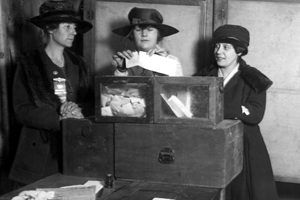
Women Vote.
1887 – Kansas women are granted the right to vote in municipal affairs, though not state and federal.
Susanna Medora Salter of Argonia was the first woman mayor in the United States to be elected in southeastern Kansas.
While drilling a well, Sam Blanchard struck salt at 300 feet. Hutchinson has been built on top of one of the world’s greatest salt deposits.
February 27, 1887 – Shoot-out with boosters — some would say hired gunmen — occurs near Leoti, leaving several people dead and wounded.
1888 – Almost a dozen salt plants were in operation at Hutchinson.
The first all-women council was elected in Oskaloosa.
1889 – Alfred Fairfax is the first African-American elected to the state legislature.
Oil is first produced in Kansas.
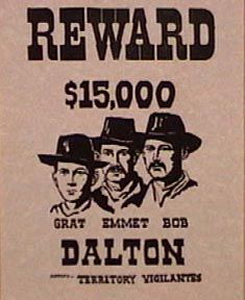
Dalton Gang Wanted Poster.
October 5, 1892 – The notorious Dalton Gang rode into Coffeyville and attempted to rob two banks, the Condon Bank and the First National Bank. They took about $25,000 in 12 minutes. A shootout followed, which claimed the lives of eight men: the outlaws Grat and Bob Dalton, Dick Broadwell, and Bill Powers; and four Coffeyville residents, Charles T. Connelly, Coffeyville city marshal (killed by Grat Dalton in “Death Alley”), Lucius M. Baldwin, George B. Cubine, and Charles Brown. Three other townsmen were wounded.
1894 – Many companies organized to develop oil and gas fields in Kansas.
A brigade of “Coxey’s Army” met its waterloo at Scott City when a train commandeered by miners at Cripple Creek, Colorado, was halted in the area by a U.S. Marshal and his deputies – bringing to a close the “last invasion of Kansas soil by anybody’s army.”
1895 – Wichita State University in Wichita was founded as Fairmount College.
1898 – Kansas enlists four regiments for service in the Spanish-American War.
1899 – Nick Chiles founded the Plaindealer, the first African-American newspaper in the United States.
The first automobile driven in Kansas was at the Emporia State Fair.
1900 – The last ethnic group to enter Kansas in large numbers was Spanish-speaking Mexicans, brought to the state as laborers for various railroad companies. Numbering only 71 in 1900, their totals reached 13,570 in 1920 and 19,042 in 1930. Their primary population concentrations were in Railroad centers.
The population of the state is 1,470,495.
Carry Nation starts crusades against saloons in Kansas.
“The Wizard of Oz” by Frank Baum is associated with Kansas.
Early 1900s – Lilla Day Monroe was the president of the Kansas Equal Suffrage Association.
1901 – Fort Hays State University at Hays was established as the Western Branch of the State Normal School at Emporia.
Carry Nation, who launched her saloon-smashing campaign in Medicine Lodge and Kiowa, brings her show to Topeka.
1903 – First helium discovery in the U.S. at Dexter, Kansas.
The Kansas State Capitol building in Topeka was completed. It was constructed over a period of 37 years from 1866 to 1903, cost a total of $3.2 million.
Pittsburg State University at Pittsburg was established as the Auxiliary Manual Training Normal School.
1905 – Charles Melvin tried to solve the “wet-dry” problem in Allen County by dynamiting the saloons on the Square. Three buildings were gone but the “wet-dry” problem was not.
1906 – The Federal Penitentiary in Leavenworth was completed.
1907-1908 – The yellow brick road leads to Dorothy’s House in Liberal, Kansas. It was built in 1907-1908 and given to the Seward County Historical Society.
1912 – Kansas woman suffrage amendment ratified.
December 2, 1912 – When the first all-women jury in Kansas entered the jury room at El Dorado, they paused, uncertain of what to do. One said: “I believe we should pray.” They bowed their heads in silent prayer, listened attentively to instructions, and returned a verdict in three hours.
1913 – Kansas oil production was 24,083 barrels. Of 2,174 holes drilled, only 483 were dry.
1914 – President Wilson sent army units, including troops from Kansas, to aid in protecting U.S. property and treaty rights concerning Mexico.
Arthur Capper became the first native Kansan elected to the office of Governor.
1916 – Kansas National Guard was sent to the Mexican border.
1917 – The Anti-Saloon League was the group established that proved integral in preventing the sale of intoxicating liquors.
Influenza epidemic.
World War I brought an unprecedented boom in agriculture because of the demand for food from the warring nations of Europe. Thousands of previously uncultivated acres were planted in wheat.
State Highway Commission was created.
Kansas had produced 25,402,521,000 cubic feet of natural gas in the past year, and 112 gas wells had been drilled.
1918 – End of World War I – 80,261 in war service from Kansas.
Shortly after 1918, the population of Wichita nearly doubled when a great oil reservoir was discovered nearby.
Minnie Grinstead is the first woman elected to Kansas Legislature.
1920s – The businessmen of Wichita went to work attracting the aircraft industry.
1921 – Amelia Earhart Putnam, a native of Atchison, made her first solo flight; she was nicknamed “Lady Lindy.”
1922 – The first radio station in Kansas is established — KFH in Wichita.
1923 – Amelia Earhart became the first woman to be granted a pilot’s license by the National Aeronautic Association.
1924 – The handkerchief-dress craze hit Kansas. At Atchison, over 250 dozen red and blue bandanas were sold to women who made dresses of them.
1925 – Forestry, Fish, and Game Commission organized.
Walter P. Chrysler, son of Henry Chrysler, was born in Wamego and grew up in Ellis, Kansas. At Ellis, Walter P. Chrysler received his public school education and learned his trade as a machinist. He was an industrialist who established the Chrysler Motors corporation in 1925.
Walter Anderson of Wichita, one of the founders of the White Castle eating houses and known as the “Hamburger King,” operated 22 White Castles. He bought the first one in Wichita with a loan of $60.
January 26, 1925 – Travel Air Manufacturing Company established. Owners Clyde Cessna, Walter Beech, and Lloyd Stearman created the “air capital of the world” in Wichita. The companies they created continue today.
1927 – The state flag of Kansas was first displayed at Fort Riley by Governor Ben Paulen in the presence of troops from Fort Riley and the Kansas National Guard. The official state flag of Kansas was adopted by the Legislature in 1927 and revised in 1961 with the Great Seal and Crest symbolizing Kansas’s history.
1928 – One-seventh of the world’s wheat crop, 12,400,000 acres, was grown in Kansas.
1929 – Mrs. T.T. Solander was the first woman to become a Kansas State Senator.
1930s – The previously uncultivated land (thousands of acres), planted to supply warring nations of Europe during World War I, was allowed to lay fallow during the recession of the 1920s and became part of the “dust bowl” of the 1930s.
1931 – Record Kansas wheat crop of 240 million bushels.
1932 – Kathryn O’Laughlin, first congresswoman elected to represent Kansas.
1934 – Drought and dust storms throughout Great Plains give rise to the “Dust Bowl” epithet
April 14, 1935 – A massive front darkens the entire Midwest in dust clouds on Black Sunday. The Dust Bowl was devastating to farmers across the plains and they eventually changed their farming practices.
“The land just blew away; we had to go somewhere.” — Kansas preacher, June 1936
1936 – New oil fields developed in western Kansas.
1937 – “Prohibition” continues in Kansas, but the legislature allows the sale of 3.2 beer; sales tax initiated.
Amelia Earhart, a native of Atchison, disappears on an around-the-world flight.
April 1, 1938 – Rural electrification reaches Kansas. This allowed Kansas farms to have the same technology, like sewing machines and milk machines, as cities across the nation.
1939 – World War II created demand for food, and prices for Kansas farm products began to rise.
“The Wizard of Oz,” a movie starring Judy Garland, makes its debut.
July 1943 – Camp Concordia, a German prisoner of war (POW) camp, was built in Concordia during World War II.
1948 – Kansas voters repeal the prohibition amendment, which had been part of the state constitution for 69 years.
1950 – There are over 30,000 producing oil wells in Kansas.
The population of the state is 1,905,000.
1950s and 1960s – Intercontinental ballistic missiles, designed to carry a single nuclear warhead, are stationed throughout Kansas facilities, ready to launch from hardened underground silos.
1952-1953 – Dwight D. Eisenhower became the first Kansan to be elected president of the United States.
1953 – The first commercial television station in Kansas, KTVH in Hutchinson.
May 17, 1954 – The U.S. Supreme Court announces its unanimous ruling on Brown v. Board of Education of Topeka. This landmark decision determined that separate but equal was inherently unequal and helped launch the Civil Rights Movement.
June 10, 1958 – A tornado hits El Dorado, Kansas, causing 15 deaths and 50 injuries.
1959 – The murder of four members of the Clutter family near Holcomb shocks the state. It becomes the basis of the book and movie entitled “In Cold Blood.”
1961 – Wichita, Kansas is known as the “Air Capital of America.”
The world’s largest and longest wheat elevator is located at Hutchinson.
1963 – Big Brutus was built at a plant near Hallowell, Cherokee County, Kansas, in 1963. West Mineral, Cherokee County, Kansas, home of Big Brutus. Costs and the fact that the EPA declared that the strip mine coal had too much sulfur and stopped its use. Big Brutus was retired in 1974 and became a museum.
June 8, 1966 – Topeka, Kansas, was struck by an F5-rated tornado, which hit various landmarks, including Washburn University. Total damage was estimated at $100 million. 17 people were killed and 550 injured.
1970 – Anti-war protests disturb several college campuses; a student union fire at Kansas University was linked to these activities.
1978 – Nancy Landon Kassebaum was the first Kansas woman to be elected to the U.S. Senate for a full term.
1980s – Kansas intercontinental ballistic missile facilities are deactivated.
1985 – Wolf Creek nuclear power plant begins commercial operation.
November 4, 1986 – A State Constitutional amendment was approved that allowed Kansans to place legal bets on dog and horse races, allowed for the State lottery, and gave Kansas the right to order liquor by the glass in public places for the first time since Prohibition.
1988 – Two native Kansans seek presidency–Bob Dole of Russell and Gary Hart of Ottawa.
March 13, 1990 – A tornado went through Hesston and Harvey Counties, staying on the ground for more than two hours. At times, it was over a half-mile wide. It caused millions of dollars of damage and two deaths.
April 26, 1990 – Several tornados occurred near Wichita, destroying 1,120 homes, damaging 571 more, injuring more than 200 people, and leaving 20 dead.
1991 – Kansans elect their first woman Governor, Joan Finney.
June-July, 1993 – The Great Flood of 1993 affects several states, including Kansas. The waters flooded 4.6 million acres of farmland — nearly one-fifth of the state’s total farm acreage — and crop losses totaled more than $434 million. There was more than $19 million in damages to the state, county, city roads, and bridges. One person died, and 46 counties were declared federal disaster areas.
1996 – Bob Dole, a U.S. Senator, ran for President of the United States.
May 3, 1999 – An F4 tornado hits Haysville, then Wichita in Sedgwick County, causing five deaths and many injuries.
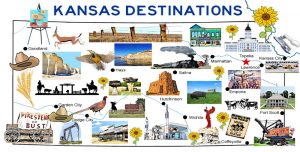
Kansas Destinations Map. Click HERE for mini-poster print.
May 4, 2007 – An F5 tornado travels through the Greensburg area, leveling at least 95% of the city and killing eleven people.
Compiled by Kathy Alexander/Legends of Kansas, updated April 2024.
Also See:

